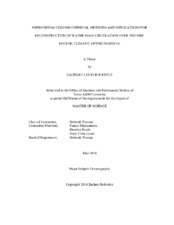| dc.description.abstract | The mid to late Eocene (49—34 Ma) is characterized as a long-term cooling (7℃) transition from greenhouse to icehouse conditions. However, this long-term cooling period was interrupted by a rapid warming event: the Mid Eocene Climatic Optimum (MECO; 40.6 Ma). During this episode of transient warming, Southern Ocean temperatures gradually rose 4 to 6°C over ~500 ka, and then warmed ~1.5°C more over a brief period at the peak of the MECO (40.0 Ma). After the peak warming, rapid cooling occurred over ~200 ka returning the Southern Ocean waters to pre-MECO temperatures.
Such prominent and transient warming may have affected (or been influenced) by a change in deep-water formation and circulation. Seawater Neodymium (Nd) isotope ratios are commonly used as a proxy for ocean circulation, however, due to the multiple column chemistry steps in sample preparation, traces of Nd are frequently lost throughout the methods. Consequently, in some samples, where Nd is scarce, it is difficult to record an isotope signal.
Here we dissect our sample preparation procedures in order to best optimize Nd collection for isotope analysis. We test the yield of Nd through the columns and suggest and alternative in order for maximum collection. Additionally, we investigate the potential relationship between the meridional overturning circulation (MOC) and climate change during the MECO using a high-resolution record of water mass Nd isotopes at Ocean Drilling Project Site 464, in the North Pacific.
An approximately -1 εNd shift concurrent with warming occurs over an ~500kyr period at about 42Ma could suggest stronger water mass intrusion from the south or an increase in weathering to the surface ventilated source water of the Pacific. Utilizing the methods adjustments compiled here along with generating a dataset over a North-South Pacific transect can provide a more clear answer to the type and magnitude of potential shifts in ocean circulation. | en |


